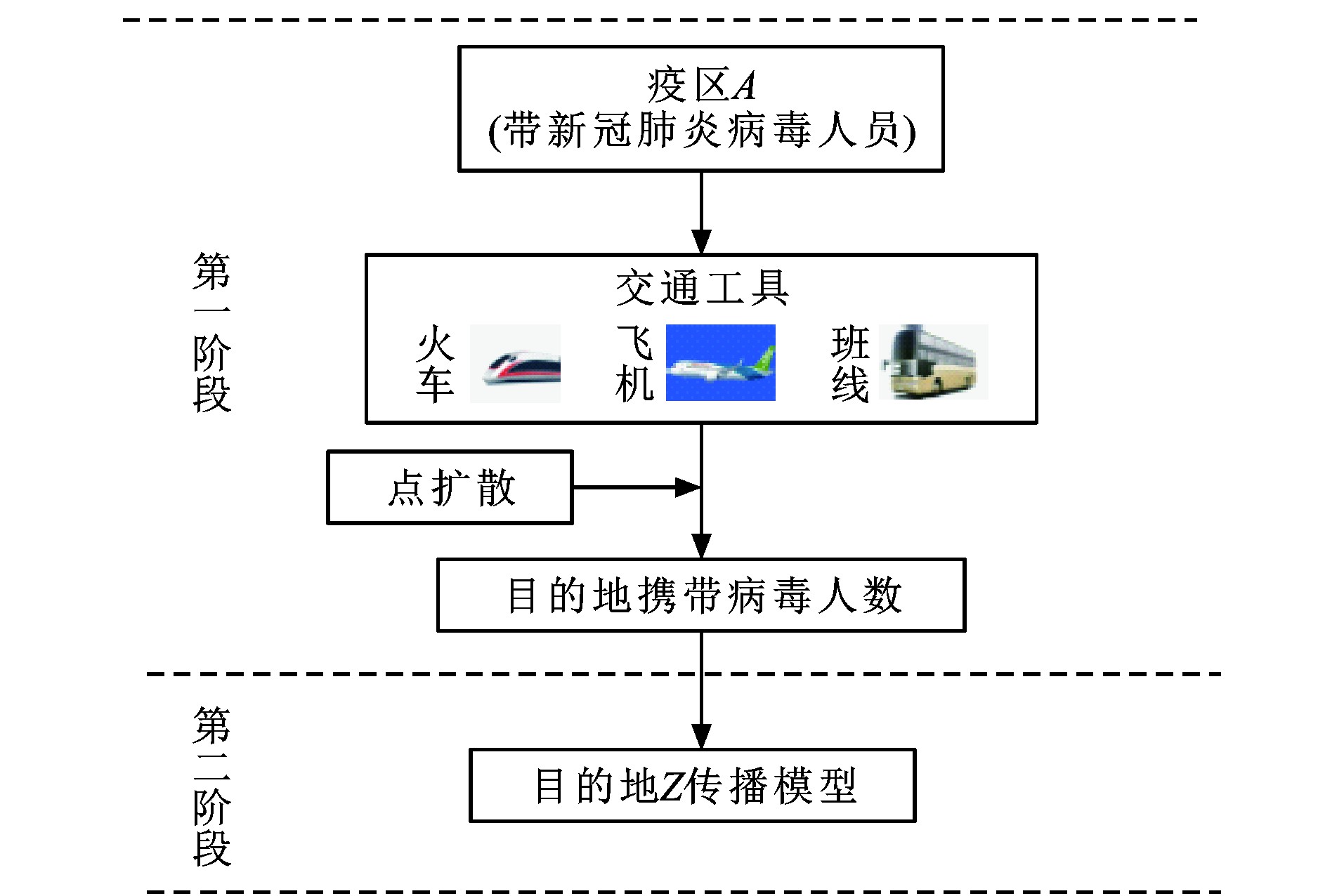Transmission mechanism of COVID-19 epidemic along traffic routes based on improved SEIR model
-
摘要: 考虑了新冠肺炎通过接触和飞沫传染、在潜伏期具有传染性等特性, 结合交通工具空间狭小、环境密闭的特点, 基于SEIR模型, 建立了考虑交通工具内病毒密度、乘客之间接触率与感染率、乘客乘坐时间等因素的交通工具内部疫情传播模型; 基于交通工具内部疫情传播形式, 考虑交通工具在多个停靠站点上下乘客的过程将疫情传播到非疫区, 建立了基于人口迁徙的疫情沿交通线路传播的模型; 利用建立的2个模型, 分析了疫情沿交通线路传播机制, 研究了武汉人口迁徙指数与确诊人数的关系, 并模拟了疫情沿高铁线路传播的过程。研究结果表明: 各省、市级累计确诊人数与人口迁徙指数有着较强的正相关性, 表明交通对疫情传播具有一定的助推作用, 在交通运输工具内有可能造成一定数量乘客被感染; 依据潜伏期的推后效应, 在一定程度上解释了除武汉之外中国其他各省市区在2020年1月31日至2月5日每日新增确诊人数处于高峰状态; 采取隔离与降低乘客上座率等措施减少乘客相互之间接触机会, 可以有效降低乘客被感染风险, 且效果显著好于通风和消毒措施。可见, 为了合理控制疫情沿交通线路传播, 在交通运输工具内应以降低上座率, 加大乘客之间的乘坐距离, 降低相互接触率等措施为主, 辅以增加通风和消毒措施。Abstract: The characteristics of COVID-19, which is transmitted by contact and droplets and is infectious in the incubation period, were considered. Combined with the narrow space and airtight environment of the vehicle and based on SEIR model, the vehicle internal epidemic transmission model was established considering the factors of virus density, contact and infection rate among passengers, and travel time. Based on the internal epidemic transmission form in the vehicle, the epidemic transmission to the non-epidemic area in the process of the vehicle loading and unloading passengers at multiple stops was considered, and a model of epidemic spread along traffic routes based on population migration was established. The transmission mechanism of the epidemic along traffic routes was analyzed using the two models. Based on the population migration index and confirmed cases in Wuhan, the relationship between confirmed cases and population migration index was analyzed, and the transmission process of the epidemic along the high-speed railway was simulated. Research result shows that the cumulative confirmed cases of each provincial and municipal level have a strong positive correlation with the population migration index, indicating that transportation has a certain role in promoting the spread of the epidemic. There may be some passengers infected within the vehicle when there are infectives. With the backward effect of incubation period, to some extent, it explains that except for Wuhan, the number of newly confirmed cases in urban areas of other provinces in China was at a peak on January 31 to February 5 in 2020. The measures such as isolation and reducing passenger occupancy to reduce the contact between passengers can effectively reduce the infection risk of passengers, and the effect is significantly better than the ventilation and disinfection measures. Therefore, in order to reasonably control the spread of the epidemic along traffic routes, some measures should be taken to reduce the occupancy rate, increase the distance between passengers and reduce the contact rate, supplemented by the measures to increase ventilation and disinfection.
-
Key words:
- traffic management /
- COVID-19 /
- epidemic transmission mechanism /
- improved SEIR model /
- traffic route
-
表 1 武汉至站点Z之间铁路传播疫情数值模拟结果
Table 1. Numerical simulation result of diseases spread via railway between Wuhan and station Z
总人数 接触率 感染率 传染源 接种率 消毒 通风 到达站点Z1感染人数 站点Z1下车感染人数 到达站点Z感染人数 站点Z下车感染人数 未下车感染人数 80 0.1 0.5 1 0.05 1 1 0.51 0.06 0.22 1.17 0.50 80 0.1 0.7 1 0.07 1 1 0.70 0.09 0.31 1.23 0.70 80 0.3 0.5 1 0.15 1 1 1.51 0.19 0.65 1.49 1.48 80 0.3 0.7 1 0.21 1 1 2.29 0.29 0.92 1.73 2.20 80 0.1 0.5 1 0.05 5 5 0.50 0.06 0.21 1.16 0.48 80 0.1 0.7 1 0.07 5 5 0.69 0.09 0.30 1.23 0.67 80 0.3 0.5 1 0.15 5 5 1.47 0.18 0.63 1.48 1.44 80 0.3 0.7 1 0.21 5 5 2.26 0.28 0.88 1.72 2.16 -
[1] 中国疾病预防控制中心新型冠状病毒肺炎应急响应机制流行病学组. 新型冠状病毒肺炎流行病学特征分析[J]. 中华流行病学杂志, 2020, 41(2): 145-151. doi: 10.3760/cma.j.issn.0254-6450.2020.02.003Epidemiology Working Group for NCIP Epidemic Response, Chinese Center for Disease Control and Prevention. The epidemiological characteristics of an outbreak of 2019 novel coronavirus diseases (COVID-19) in China[J]. Chinese Journal of Epidemiology, 2020, 41(2): 145-151. (in Chinese). doi: 10.3760/cma.j.issn.0254-6450.2020.02.003 [2] YANG Zi-feng, ZENG Zhi-qi, WANG Ke, et al. Modified SEIR and AI prediction of the epidemics trend of COVID-19 in China under public health interventions[J]. Journal of Thoracic Disease, DOI: 10.21037/jtd.2020.02.64. [3] 冯佳园. 传染病发生和流行的主要影响因素趋势预测研究[D]. 北京: 北京协和医学院, 2009.FENG Jia-yuan. Study on the trend prediction of the main factors affecting the occurrence and prevalence of infectious diseases[D]. Beijing: Peking Union Medical College, 2009. (in Chinese). [4] CHEOWELL G, HENGARTNER N W, CASTILLO-CHAVEZ C, et al. The basic reproductive number of Ebola and the effects of public health measures: the cases of Congo and Uganda[J]. Journal of Theoretical Biology, 2004, 229(1): 119-126. doi: 10.1016/j.jtbi.2004.03.006 [5] 王拉娣. 传染病动力学模型就控制策略研究[D]. 上海: 上海大学, 2004.WANG La-di. Research on the epidemic models and controlling strategy of epidemic diseases[D]. Shanghai: Shanghai University, 2004. (in Chinese). [6] LEKONE P E, FINKENSTADT B F. Statistical inference in a stochastic epidemic SEIR model with control intervention: Ebola as a case study[J]. Biometrics, 2006, 62(4): 1170-1177. doi: 10.1111/j.1541-0420.2006.00609.x [7] 刘云忠, 宣慧玉, 林国玺. SARS传染病数学建模及预测预防控制机理研究[J]. 中国工程科学, 2004, 6(9): 60-65. https://www.cnki.com.cn/Article/CJFDTOTAL-GCKX200409011.htmLIU Yun-zhong, XUAN Hui-yu, LIN Guo-xi. Mathematical and predictive models of SARS epidemic disease and mechanism of prevention and control[J]. Engineering Science, 2004, 6(9): 60-65. (in Chinese). https://www.cnki.com.cn/Article/CJFDTOTAL-GCKX200409011.htm [8] ZHANG Juan, LOU Jie, MA Zhi-en, et al. A compartmental model for the analysis of SARS transmission patterns and outbreak control measures in China[J]. Applied Mathematics and Computation, 2005, 162(2): 909-924. doi: 10.1016/j.amc.2003.12.131 [9] 郭树敏. 传染性疾病传染机制与控制的系统研究[D]. 北京: 中国航天第二研究院, 2010.GUO Shu-min. System research on transmission mechanism and control of some infectious diseases[D]. Beijing: The Second Academy of China Aerospace, 2010. (in Chinese). [10] CHOWELL G, CASTILLO-CHAVEZ C, FENIMORE P W, et al. Model parameters and outbreak control for SARS[J]. Emerging Infectious Diseases, 2004, 10(7): 1258-1263. doi: 10.3201/eid1007.030647 [11] LIPSITCH M, COHEN T, COOPER B, et al. Transmission dynamics and control of severe acute respiratory syndrome[J]. Science, 2003, 300: 1966-1970. doi: 10.1126/science.1086616 [12] BREBAN R, RIOU J, FONTANET A. Interhuman trans-missibility of middle east respiratory syndrome coronavirus: estimation of pandemic risk[J]. Lancet, 2013, 382: 694-699. doi: 10.1016/S0140-6736(13)61492-0 [13] 蔡磊. 基于2014-2015年埃博拉疫情数据的统计建模与重要参数分析[D]. 广州: 暨南大学, 2016.CAI Lei. Statistical modeling and analysis of important parameters based on 2014-2015 Ebola epidemic data[D]. Guangzhou: Jinan University, 2016. (in Chinese). [14] 徐展凯. 基于个体的传染病传染模型构建及应用[D]. 北京: 人民解放军军事医学科学研究院, 2016.XU Zhan-kai. The building of individual-based infectious disease model and applications[D]. Beijing: Academy of Military Medical Sciences, 2016. (in Chinese). [15] 张殿业, 郭寒英. 交通运输通道防控非典型肺炎(SARS)疫情的作用研究[J]. 交通运输工程与信息学报, 2003, 1(1): 31-36. https://www.cnki.com.cn/Article/CJFDTOTAL-JTGC200301004.htmZHANG Dian-ye, GUO Han-ying. Effect of traffic and transportation preventing and controlling sever acute respiratory syndrome epidemic situation[J]. Journal of Transportation Engineering and Information, 2003, 1(1): 31-36. (in Chinese). https://www.cnki.com.cn/Article/CJFDTOTAL-JTGC200301004.htm [16] 郭寒英, 张殿业, 石红国. 交通运输突发疫情扩散理论与模型研究[J]. 铁道运输与经济, 2004, 26(2): 65-67. https://www.cnki.com.cn/Article/CJFDTOTAL-TDYS200402027.htmGUO Han-ying, ZHANG Dian-ye, SHI Hong-guo. Spreading theory and model study of broke-out diseases in traffic and transportation[J]. Railway Transport and Economy, 2004, 26(2): 65-67. (in Chinese). https://www.cnki.com.cn/Article/CJFDTOTAL-TDYS200402027.htm [17] 程子龙. 面向传染病传染的人工交通系统建模关键技术研究[D]. 长沙: 国防科学技术大学, 2012.CHENG Zi-long. Research on key technology of artificial transportation system modeling toward infection transmission[D]. Changsha: National University of Defense Technology, 2012. (in Chinese). [18] 杨华, 李小文, 施宏, 等. SARS沿交通线路的"飞点"传染模型[J]. 遥感学报, 2003, 7(4): 251-255.YANG Hua, LI Xiao-wen, SHI Hong, et al. "Fly dots" spreading model of SARS along transportation[J]. Journal of remote sensing, 2003, 7(4): 251-255. (in Chinese). [19] 曹春香, 李小文, 闫珺, 等. 地理空间信息与SARS疫情走势[J]. 遥感学报, 2003, 7(4): 241-244. https://www.cnki.com.cn/Article/CJFDTOTAL-YGXB200304000.htmCAO Chun-xiang, LI Xiao-wen, YAN Jun, et al. Geo-spatial information and analysis of SARS spread trend[J]. Journal of Remote Sensing, 2003, 7(4): 241-244. (in Chinese). https://www.cnki.com.cn/Article/CJFDTOTAL-YGXB200304000.htm [20] 刘亚岚, 阎守邕, 李小文, 等. 中国内地人口流动空间规律研究及其在SARS控制宏观决策中的应用[J]. 遥感学报, 2003, 7(4): 273-276. https://www.cnki.com.cn/Article/CJFDTOTAL-YGXB200304006.htmLIU Ya-lan, YAN Shou-yong, LI Xiao-wen, et al. Study on population migration characteristics in mainland China and its applications to decision-making for SARS control[J]. Journal of Remote Sensing, 2003, 7(4): 273-276. (in Chinese). https://www.cnki.com.cn/Article/CJFDTOTAL-YGXB200304006.htm [21] ZHAO Shi, ZHUANG Zi-an, RAN Jin-jun, et al. The association between domestic train transportation and novel coronavirus (2019-nCoV) outbreak in China from 2019 to 2020: a data-driven correlational report[J]. Travel Medicine and Infectious Disease, 2020, 33: 101568-1-3. [22] 张云. 中国大陆地区甲型H1N1流感疫情传播的建模与分析[D]. 北京: 北京师范大学, 2011.ZHANG Yun. Modeling and analysis of influenza a (H1N1) epidemiology in mainland of China[D]. Beijing: Beijing Normal University, 2011. (in Chinese). [23] WANG L, WU J T. Characterizing the dynamics underlying global spread of epidemics[J]. Nature Communications, 2018, DOI: 10.1038/s41467-017-02344-z. [24] BROCKMANN D, HELBING D. The hidden geometry of complex network-driven contagion phenomena[J]. Science, 2013, 342: 1337-1342. [25] LIU Tao, HU Jian-xiong, KANG Min, et al. Transmission dynamics of 2019 novel coronavirus (2019-nCoV)[J]. BioRxiv, DOI: 10.1101/2020.01.25.919787. [26] WU J T, LEUNG K, LEUNG G M. Nowcasting and forecasting the potential domestic and international spread of the 2019-nCoV outbreak originating in Wuhan, China: a modelling study[J]. Lancet, DOI: 10.1016/S0140-6736(20)30260-9. [27] ZHAO Shi, LIN Qian-yin, RAN Jin-jun, et al. Preliminary estimation of the basic reproduction number of novel coronavirus (2019-nCoV) in China, from 2019 to 2020: a data-driven analysis in the early phase of the outbreak[J]. International Journal of Infectious Diseases, 2020, DOI: 10.1016/j.ijid.2020.01.050. [28] 中华预防医学会新型冠状病毒肺炎防控专家组. 新型冠状病毒肺炎流行病学特征的最新认识[J]. 中华流行病学杂志, 2020, 41(2): 139-144. https://www.cnki.com.cn/Article/CJFDTOTAL-ZRYX202002002.htmSpecial Expert Group for Control of the Epidemic of Novel Coronavirus Pneumonia of the Chinese Preventive Medicine Association. An update on the epidemiological characteristics of novel coronavirus pneumonia (COVID-19)[J]. Chinese Journal of Epidemiology, 2020, 41(2): 139-144. (in Chinese). https://www.cnki.com.cn/Article/CJFDTOTAL-ZRYX202002002.htm [29] LIN Kun, FONG D Y T, ZHU Bi-liu, et al. Environmental factors on the SARS epidemic: air temperature, passage of time and multiplicative effect of hospital infection[J]. Epidemiology and Infection, 2006, 134(2): 223-230. [30] 陈文江, 吴开琛, 吴开录, 等. 运用数学模型探讨SARS聚集性传播的机制[J]. 中国热带医学, 2004, 4(1): 20-23. https://www.cnki.com.cn/Article/CJFDTOTAL-RDYX200401007.htmCHEN Wen-jiang, WU Kai-chen, WU Kai-lu, et al. Approach to the mechanism of cluster transmission of SARS by mathematical model[J]. China Tropical Medicine, 2004, 4(1): 20-23. (in Chinese). https://www.cnki.com.cn/Article/CJFDTOTAL-RDYX200401007.htm -





 下载:
下载:






